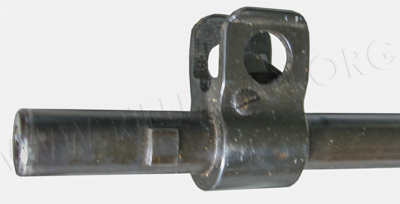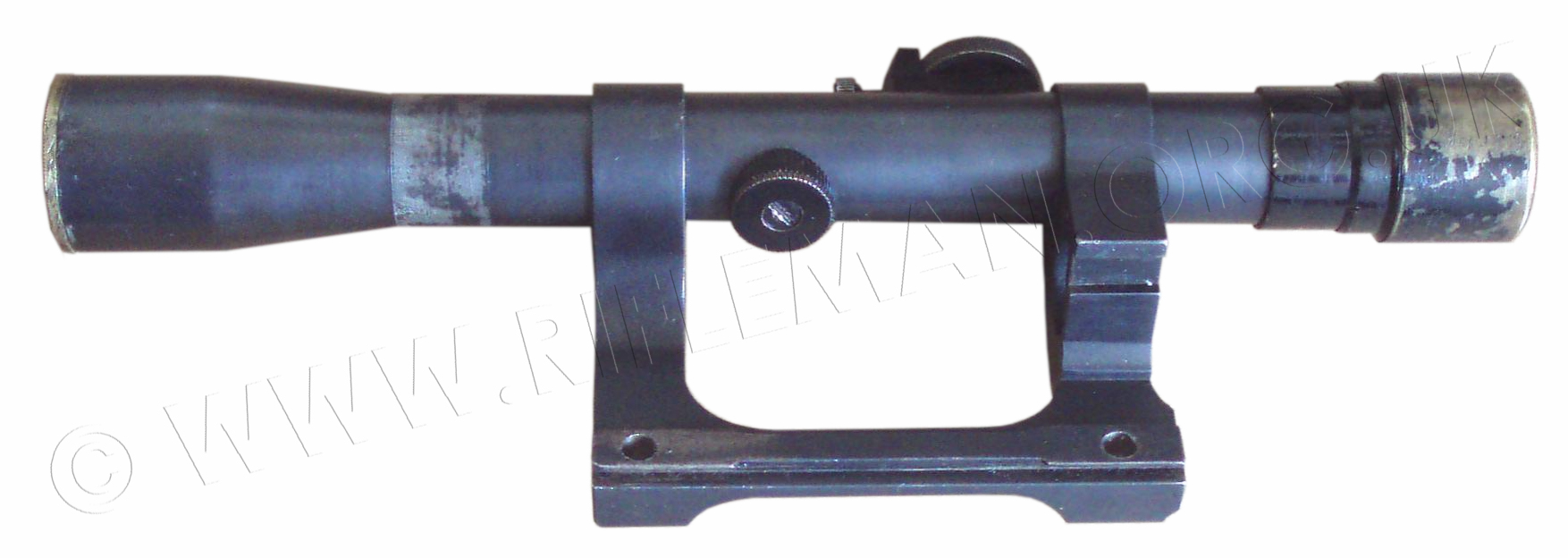See other Lee-Enfield Rifles:
and the related Enfield Pattern '13 trials rifle
Please note that Ainley rifle has been photographed by courtesy of the trustees of the Small Arms School Collection at Warminster, and are copyright to both that institution and to WWW.RIFLEMAN.ORG.UK, to whom the remainder also have rights reserved.
The Infantry & Small Arms School Collection at Warminster also holds a most unusual variation of what is catalogued by them as a Pattern '13 rifle. This a not unreasonable annotation, as the rifle is evidently built around a heavily modified version of the Mauser action on which the trials P'13 and production P'14 rifles were based.
In the mid-1930s the War Office was preparing for a potential requirement for the use of small-arms to combat light armoured vehicles. Already in the pipeline was Captain Boys' design for an infantryman portable purpose-built anti-tank rifle, and his Boys .55 calibre Anti-Tank Rifle is covered on this site, including in its several prototyped configurations.
Another option, even more portable, was a high powered individual infantry weapon. A separate development team at Enfield was led by Captain J.R. Ainley, and, in common with Captain Boys' anti-tank rifle, the resultant high velocity weapon shown on this page became known as the "Ainley Rifle".
Very shortly before the commencement of the Second World War, in mid 1939, the trialling of two prototypes was already under way. The proposal had been for a weapon producing a muzzle velocity in the region of 3,700 feet per second, and the testing of various calibres of ammunition up to this point resulted in the selection of a .276 inch cartridge. The calibre of this round, however, was the only similarity to that of the original P'13 rifle; it was effectively a magnum cartridge.
Two prototypes were built at Enfield and, subsequently, orders for four trials rifles were given; two for production by the Birmingham Small Arms Company, and two by Accles & Shelvoke Ltd. The former two were serial numbered 3 & 4, and the latter pair 5 & 6. No.3 is the Warminster rifle illustrated on this page, and No.4 was originally in the Enfield Pattern Room, but now lies in the National Firearms Collection at the Leeds Royal Armouries.
These images are here shown by kind permission of the O.C. , S.A.S.C. Weapons Collection,
and are joint copyright to the Small Arms School and www.rifleman.org.uk.
Hover over or Click image to bring up hi-res file and magnifier
The rifle bears, on the LHS of the butt, SAC brass tag number 1160,
and is labelled as Experimental, being to Enfield Drawing No. DD (E) 2012

The top of the receiver is engraved with the Enfield drawing number, beneath which is the probable serial no. "3".
The configuration of the rifle could be considered almost sporting, or certainly of later military design,
with its trimmed back fore-end wood, and indeed hints of the
1971 7.62mm NATO calibre L42A1 sniping conversion of the Lee-Enfield Rifle No.4,
and the associated L39A1 military target rifle.
Hover over or Click image to bring up hi-res file and magnifier
The rear-sight adjustment is somewhat reminiscent of that of the drum system on the Mk.1 Bren light machine gun.
The large lower drum is for elevation, and the small upper knurled wheel for windage.
As the rifle was also intended for sniping with its armour-piercing ammunition,
and potentially at comparatively long range, a dovetailed groove was machined
into the left-hand-side of the receiver body for the fitting of the mount for a telescopic sight.

The mass of the high-pressure receiver, along with the robust sighting arrangement,
renders the action's body a particularly heavy component.

The windage calibration appears to cover 15 minutes each side,
in five minute divisions, but with a vernier for fine adjustment.
It all seems an exceptionally strong design, if tending towards 'clunky'.

We are able to illustrate the Enfield drawing of the rifle, Drg. no. DD 2012,
by courtesy of the Royal Armouries' National Firearms Collection,
who hold copyright of the original micro-fische of the plan that was sadly in poor condition.
N.B. Copyright of this newly processed image is held by www.rifleman.org.uk.
Hover over image for high resolution zoom
Hover over or Click image to bring up hi-res file and magnifier
The drawing of the cartridge to which this drawing refers is shown further down this page.
The unique action design is below overlaid on the rifle's image,
showing the trigger mechanism, striker, chamber and magazine arrangement.

Below: again, in some areas, the rifle shows similarity to the Lee-Enfield Rifle No.4,
with the barrel's bayonet attachment lug arrangement ahead of the fore-sight block.
Comparison with the fore-sight block with that of a
Pattern '14 .303" calibre rifle will show the latter to be significantly higher.
This is because the .303CF round was of a lower muzzle velocity, generating a higher arcing trajectory.


Even two or three designs of muzzle-brake were tested,
but a combination of factors resulted in the halting of the project,
not least of which was the progression of the war itself,
and the need to concentrate production capability on even more urgent equipment.
Also, there had been delays in finalising the ammunition and, in the meantime,
the hitherto poor performance of the existing armour-piercing .303 Mk.VIIP round,
which had proved incapable of penetrating German loop-holed sniper plates,
had been greatly improved with the introduction of the .303 Mark.VIIIW cartridge.
By courtesy of (the now late) Tony Edwards, we show the Enfield drawing no. DD 8158 of the cartridge.

The heavy recoil of the rifle, and the complexity of satisfactorily countering this,
was also a significant factor in its failure to enter production,
along with its excessive muzzle flash and exceptionally loud report.
The late Herbie Woodend, then curator of the Enfield Pattern Room,
wrote of the Ainley rifle in his most useful reference book BRITISH RIFLES
that recorded a number of significant rifles held in the collection.
The Pattern Room was originally at Enfield, and and subsequently moved
under Herbie's supervision to the Royal Small Arms factory in Nottingham.
(The collection now resides as the National Firearms Collection at the Royal Armouries in Leeds).
The Pattern Room's example of the rifle, Serial No. 4, was then held as Exhibit No. RB 344
Currently Object No. PR.5847 in the N.F.C. (Leeds)
___________
Rifle, Magazine, Experimental, ·276" High Velocity
L 45·5 in (115·6 cm) B 25·7 in (65·3 cm) w 9lb (4·08 kg)
Early in 1936 the Small Arms Committee considered the question of a new service rifle, particular emphasis being placed on armour penetration. The original specification called for a muzzle velocity of 3,700 ft/sec and, after some two years development work in a variety of calibres, a magnum type ·276" rimless round was selected as the most promising cartridge for the proposed rifle. The design of the new rifle was undertaken at Enfield by a team headed by Captain J. R. Ainley, the weapon being referred to locally as the 'Ainley Rifle'. By mid-1939 two Enfield made prototypes were under test and, in anticipation of large scale production, orders were confirmed with two Birmingham companies, BSA Guns Ltd and Aedes and Shelvoke Ltd, for both firms to make two rifles to the Enfield design. The BSA rifles were allocated serial numbers 3 and 4, the Aedes and Shelvoke rifles were num- bered 5 and 6. Like the experimental ·276" Patt. 13 Rifle (see RB 311), this project was shelved due to the outbreak of war and major problems in cartridge design. By 1940 all work on this rifle had ceased.
The action of the rifle is similar in style to the Patt. 14 (No. 3) Rifle with a Mauser type bolt system and a built-in 5-round magazine. It is half stocked, on the lines of a sporting rifle, and is fitted with an alloy butt cap similar to that on the Bren Mk. I LMG. Two strong buffer springs are housed in the butt to ease recoil.
The backsight is a drum type, also similar to the Mk. I Bren, mounted on the left body and graduated for elevation from 0 to 45°. A dovetailed channel for a telescope sight mount runs along the left body. This specimen is marked on the receiver ring with the drawing number, DD(E) 2012, serial number 4, and the BSA trademark of three crossed [piled: Ed] rifles.
The telescope sight mentioned in Herb Woodend's write up, an Aldis style Pattern 1918, is also held in the Warminster collection.
The 'scope has evidently also been used in a previous mount with more widely spaced ring clamps, indicating that it is possibly a surplus BSA 'scope such as those fitted to the P'14 sniping rifles that were arsenal refurbished in the U.K then supplied to and issued by the Irish Free State in the 1930s.

The following searchable flip-page facsimile is of the 1939 Ordnance Board proceedings minutes on the trialling of the Ainley high velocity rifle, along with a Soley Arms adapted Pattern '14 SMLE-styled example.
There is also inclusion and mention of the then current situation regarding the Lee-Enfield Rifle No.4, developed from the Rifle No.1 Mk.VI, and of the .55-inch calibre Boys Anti-tank rifle.
References in the minutes to a self-loading rifle relate to the Ordnance's acquisition of a single early model of Garand rifle that became the M1. It is written that the fact that an example of the rifle was in British hands at such an early stage could have been contentious, and that the rifle was not to be named as the Garand anywhere in documentation or in the field. It was given the temporary nomenclature "Y.S.L.", the uncertain origin of which has been suggest as being "Yankee Self-Loader".
These minutes cover the period from commencement of trials in March 1939 until the decision to not further proceed with the Ainley H.V. (High Velocity) rifle's development, made in January 1940.
Irrelevant sections have been redacted.
Further detailed information on the nominal .280 inch ammunition, and much more, can be found
on the comprehensive website of the late Tony Edwards, which site is presently residing here:
See also the Enfield Pattern '13 trials rifle,
and the Enfield No.3 Rifle (Pattern 1914) training version,
an extremely rare British WW1/II Sniper version of the P'17 rifle
and the Soley Arms Co. Experimental adaptation of the P'14 (No.3) Rifle
plus the Lee-Enfield Rifle No.1 Mk.VI
Return to: TOP of PAGE
See this website's Raison d'être